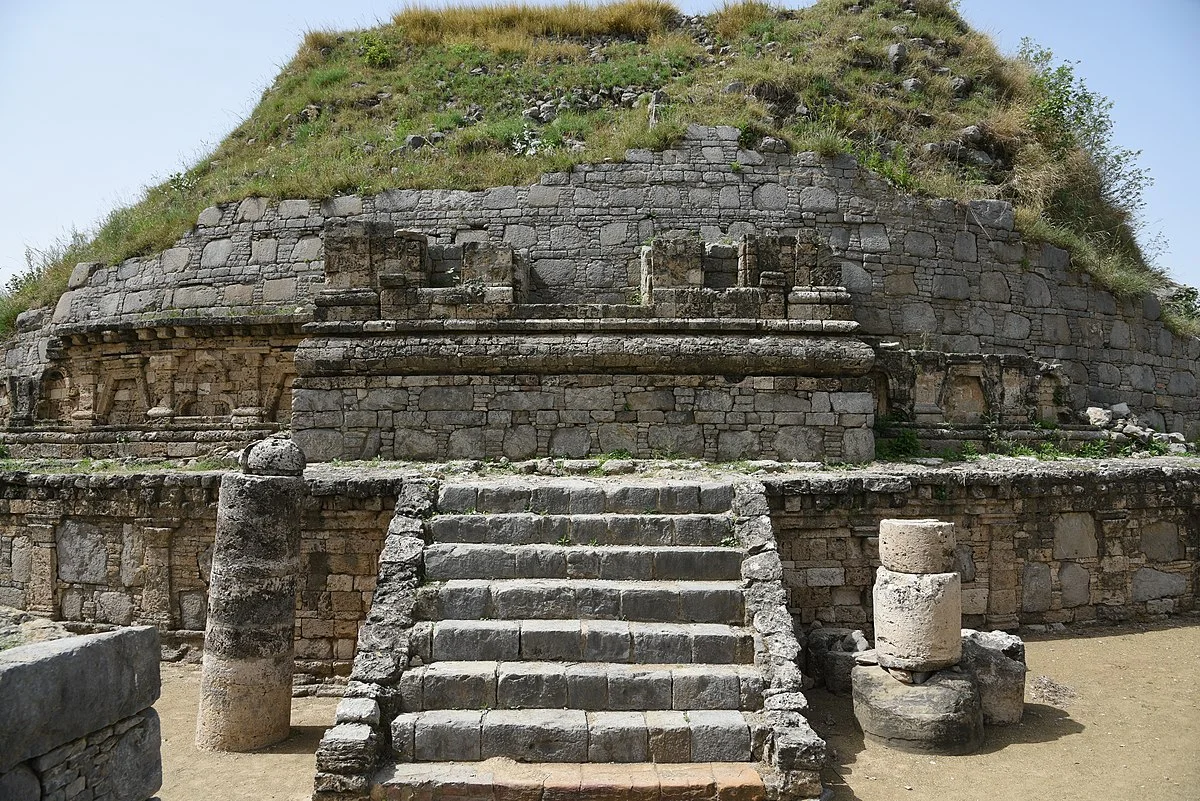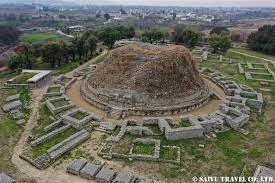INTRODUCTION

The Great Stupa of Taxila, also known as the Dharmarajika Stupa, is a Buddhist stupa located close to Taxila, Pakistan.
In the third century BC, Ashoka constructed it over the Buddha’s remains.
The stupa is a component of the Ruins of Taxila, which were included in the UNESCO World Heritage List in 1980, together with the sizable monastery complex that subsequently grew up around it.
The primary stupa has a circular floor layout, measuring 45 feet in height and 131 feet in diameter.
According to Marshall, the word Dharmarajika is derived from Dharmaraja, which was the moniker given to Buddha, who was the real Dharma Raja (Lord of Law). Additionally, it’s thought that the name “Dharmarajika” comes from the term “Dharmaraja,” which refers to Ashoka, the Mauryan ruler.

Another name for the stupa that is often used is Chir Tope, which means “Sacred Hill”.
LOCATION
The Dharmarajika Stupa is located northeast of Taxila cantonment, along the PMO Colony Road, approximately 3 kilometers east of the Taxila Museum.
The stupa was situated close to Sirkap, an ancient city that is now a part of the Taxila Ruins.
The stupa and its monastic community are situated around one kilometer outside of Sirkap, in accordance with the Buddha’s advice that monasteries should not be situated “too far” or “too close” to nearby towns.

The structures around the main stupa include three different styles of brickwork, which allude to the various periods’ contributions to the building activities.
WHAT IS A STUPA?
In Buddhism, the stupa—Sanskrit meaning “heap”—is a significant kind of Buddhist building. In general, it is regarded as a sepulchral monument, which is a location for interment or a container for holy items. A stupa is essentially a stone-faced soil burial mound.
ABOUT DHARMARAJIKAKA
Dharmarajika is also known as Chir top because when the people dig the stupa it is ripped from the top side part and from that it is called chir top among the people.

The Dharmarajika complex is divided into two sections: the stupa area, which houses the Great Stupa and several other structures from various eras, and the monastic area, which has monasteries from various eras.
Upon excavating the site, Sir John Marshall discovered several Buddha relics, indicating that Buddha had formerly lived here once.
They also discovered several stupas, temples, and the homes of bhikshus. Throughout the excavation phase, several utensils, pots, and coins were found.
The Dharmarajika features a circular floor layout, a 45-foot-tall drum, a raised terrace surrounding the base, and four flights of steps, one at each of the cardinal points.
A paved ambulatory corridor encircles the whole structure, and its exterior is further besieged by a large number of votive stupas.

The main stupa measures 150 feet east to west and 146 feet north to south, including the terrace and steps. The Great Stupa’s body has an average diameter of 115 feet, with a berm projection of 8 feet and an additional 8 feet 6 inches for the steps, showcasing how excellent the framework is.
Additional stupas have repeatedly expanded upon the ambulatory tunnel that surrounds the stupa.
The complex’s monastic portion is made up of many monasteries from various eras that were constructed in accordance with the needs of the day.
The ancient stupa was embellished with several Buddha statues and jataka friezes. During the first digs, several important objects like jewelry, antiques, and donated coins were also found. Materials utilized in the building include glass, lime pilaster, rubble masonry, and kanjur stone.
The seven-tiered umbrella stone that formerly topped the stupa is thought to have fallen.
HISTORY
The Dharmarajika Stupa is said to have been constructed over the ruins of an even earlier stupa that King Ashoka of the Mauryans had constructed in the third century BC.

It was thought that the stupa was rebuilt in the second century CE during the Kushan era to contain Buddha artifacts that could have come from older structures.
Buddhist scriptures state that the Dharmarajika structure was tiled with vibrant glass tiles and that the fragrant was used during religious ceremonies.
The discovery of Indo-Greek coins at the location, which dates to the second century BC, raises the possibility that a sacred monument was first built there.
Throughout the Dharmarajika site, smaller stupas that precede the main stupa are scattered, encircling an older core stupa in an asymmetrical pattern.
It is known that the original core stupa had a plaster circumambulation route embellished with geometrically patterned shell bangles. There were probably four gates in axial directions on the ancient stupa.
After coming under Persian Sassanid authority, the location experienced a spell of inactivity.
Numerous monasteries and stupas were erected on the site during the late Kushan and Kidarite eras when significant advancements took place.
DESTRUCTION OF DHARMARAJIKA
In the fifth century CE, the White Huns destroyed the site, which was later abandoned. The Hun king Mihirakula and several later monarchs persecuted the Buddhists in the area.
It is claimed that during his rule, more than a thousand Buddhist temples were demolished across Gandhara.
The White Huns ravaged neighboring Peshawar in addition to the Taxilan ruins.
EXCAVATION OF DHARMARAJIKA

Sir John Marshall dug up the stupa in 1913. Prior to Marshall’s discovery, the stupa had been stolen several times and was severely damaged.
Marshall pointed out that in order to steal valuable artifacts from the stupa, a huge trench that required a lot of work had to be constructed in the past. By 1934, enough of the site had been discovered to allow one to understand its magnitude.
In the open space directly south of the stupa, human skeletons were found. These bones might be those of monks who perished in the White Hun invasion.
MONASTRIES
The lesser stupas that encircled the main stupa were probably created as a group as part of a project supported by a single patron, and they were completed about 200 years after the great stupa.
The Indo-Scythian period is represented in the other stupas that were constructed by different patrons further along the northern part of the site.
The “Northern Avenue,” which is made up of these stupas, was formerly a processional avenue with a number of little shrines containing devotional figures.
Religious conservatives, who were reluctant to fully embrace the new practice of employing imagery in religious practice, are probably to blame for devotional pictures being confined to the complex’s peripheral.

The stupas around the Dharmarajika Stupa were erected by private benefactors, as opposed to being a part of the Sanchi structures.
The early monastery cells were constructed as a row of chambers with a verandah next to the stupa. About 300 years after the stupa’s construction, the verandah design was abandoned in favor of monastic housing quarters encircling quadrangles to the immediate north, northeast, and east of the structure.
The two courtyards that made up the northern monastery were centered on enormous stupas. Thirteen monks are thought to have resided in the smaller eastern courtyard.
At least fifty monastic cells, a stupa, and what is probably a multistory building makeup Monastery G, which is situated just west of the stupa. Monastery M was located in the far northwest part of the grounds, and it included a tiny courtyard with its own stupa. Monastery M is part of an extended residential monastery that is roughly north-south orientated.

The remnants of two stupas, currently known as E1 and E2, are located along the monastery’s southern boundary.
E1 was constructed inside an already-existing cell, whereas E2 was a more intricate stupa with a tiny tunnel for walking about. Both stupas were probably off-limits to visitors.
CONCLUSION
The most striking of all the ruins around Taxila was the Dharmarajika stupa. When Taxila was a significant city in the Mauryan empire, the stupa was constructed. Some traditions state that Ashoka, the Mauryan ruler, gave Taxila sacred relics from Gautama Buddha.
In order to safeguard the sacred relics, King Ashoka constructed the Dharmarajika stupa in Taxila around the third century BC. In fact, during excavations, archaeologists discovered a silver coffin containing pieces of bone, which are currently housed in the Taxila Museum.



71 Comments
SDiozxswidly
маркетплейс для реселлеров маркетплейс аккаунтов соцсетей
Zazacwidly
маркетплейс аккаунтов соцсетей гарантия при продаже аккаунтов
SDiozxswidly
купить аккаунт гарантия при продаже аккаунтов
Zazacwidly
безопасная сделка аккаунтов перепродажа аккаунтов
Olasxwidly
маркетплейс аккаунтов магазин аккаунтов
Josephwidly
маркетплейс аккаунтов гарантия при продаже аккаунтов
RobertTig
магазин аккаунтов продать аккаунт
Olivewidly
безопасная сделка аккаунтов аккаунт для рекламы
Droswidly
купить аккаунт маркетплейс аккаунтов
Olivewidly
магазин аккаунтов социальных сетей купить аккаунт
Peterdaw
магазин аккаунтов маркетплейс аккаунтов
RichardTen
продажа аккаунтов соцсетей https://magazin-akkauntov-online.ru/
JamesCledo
заработок на аккаунтах биржа аккаунтов
Olivewidly
биржа аккаунтов https://prodat-akkaunt-online.ru
Bryantbeini
услуги по продаже аккаунтов продажа аккаунтов соцсетей
RichardTen
магазин аккаунтов купить аккаунт
DavidNaisk
Account Selling Platform https://buyverifiedaccounts001.com/
JasonRah
Gaming account marketplace Website for Buying Accounts
MichaelMibra
Guaranteed Accounts Website for Buying Accounts
WalterFlact
Verified Accounts for Sale Account Buying Platform
JaredSoals
Marketplace for Ready-Made Accounts Ready-Made Accounts for Sale
BrianCoaps
Sell Account Secure Account Sales
Ronaldhex
Website for Selling Accounts https://buyagedaccounts001.com
ThomasGat
Sell accounts Buy and Sell Accounts
BruceCUBOW
Account Selling Service Buy and Sell Accounts
Williamsep
Account Trading Platform Buy and Sell Accounts
Ronaldhex
Account Exchange Service https://socialmediaaccountsale.com/
EdmundDeats
account marketplace sell account
BrandonGuede
sell account find accounts for sale
RomeoGaH
account buying platform account trading
Keithvet
accounts marketplace account trading service
RobertGeasy
sell accounts guaranteed accounts
Hectorwem
account market account market
CarlosMar
account buying service account trading service
Richardusero
secure account sales gaming account marketplace
Stephentraky
find accounts for sale secure account purchasing platform
Carlosjeape
find accounts for sale sell accounts
Stevenslace
account trading platform account buying platform
Clydedoulp
account purchase account exchange service
JohnnyDot
buy and sell accounts accounts for sale
ThomasPouff
profitable account sales account purchase
PhilipDib
buy and sell accounts account buying platform
RandalOxilt
secure account sales account trading service
Zacharymax
account acquisition database of accounts for sale
RichardMouse
website for buying accounts website for buying accounts
Kevinjoipt
database of accounts for sale buy and sell accounts
Thomasnussy
gaming account marketplace guaranteed accounts
NathanKiz
buy pre-made account account buying service
BruceObere
social media account marketplace account catalog
Danielnot
accounts for sale buy accounts
Jasonvon
online account store https://accounts-buy-now.org
ThomasBeada
online account store accounts for sale
accounts-offer.org_Cousy
buy account https://accounts-offer.org
accounts-marketplace.xyz_Cousy
database of accounts for sale https://accounts-marketplace.xyz
buy-best-accounts.org_Cousy
accounts market account market
social-accounts-marketplaces.live_Cousy
buy account https://social-accounts-marketplaces.live/
accounts-marketplace.live_Cousy
sell pre-made account https://accounts-marketplace.live
social-accounts-marketplace.xyz_Cousy
website for selling accounts https://social-accounts-marketplace.xyz
buy-accounts.space_Cousy
verified accounts for sale buy-accounts.space
buy-accounts-shop.pro_Cousy
find accounts for sale https://buy-accounts-shop.pro
accounts-marketplace.art_Cousy
buy pre-made account https://accounts-marketplace.art
social-accounts-marketplace.live_Cousy
account buying service https://social-accounts-marketplace.live
buy-accounts.live_Cousy
account catalog https://buy-accounts.live
accounts-marketplace.online_Cousy
purchase ready-made accounts accounts marketplace
accounts-marketplace-best.pro_Cousy
account selling platform https://accounts-marketplace-best.pro
akkaunty-na-prodazhu.pro_Cousy
маркетплейс аккаунтов соцсетей https://akkaunty-na-prodazhu.pro
rynok-akkauntov.top_Cousy
магазин аккаунтов https://rynok-akkauntov.top
kupit-akkaunt.xyz_Cousy
маркетплейс аккаунтов kupit-akkaunt.xyz
akkaunt-magazin.online_Cousy
маркетплейс аккаунтов соцсетей https://akkaunt-magazin.online/
akkaunty-market.live_Cousy
продать аккаунт https://akkaunty-market.live
kupit-akkaunty-market.xyz_Cousy
продажа аккаунтов маркетплейсов аккаунтов